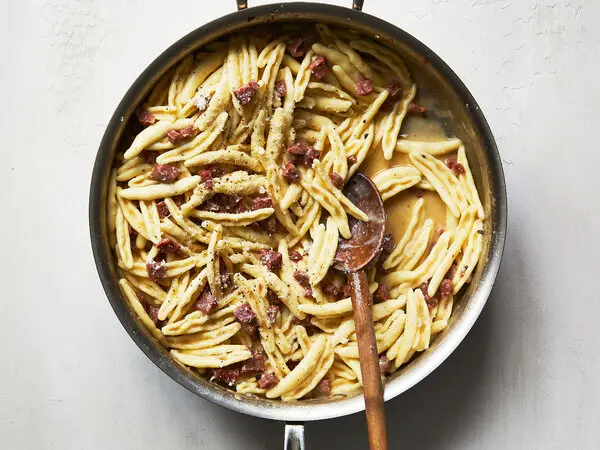
Ciao, pasta lovers! Today, we’re diving deep into the heart of Roman cuisine, exploring the legendary “Big Four” pasta dishes that have captivated taste buds for generations. These aren’t just recipes; they’re culinary masterpieces built on tradition, simplicity, and the magic of emulsification.
Forget those heavy, cream-laden sauces. These Roman classics rely on the humble yet powerful combination of pasta water, finely grated cheese, and a touch of culinary finesse to create silky smooth, flavor-packed sauces that will have you saying “arrivederci” to store-bought jars forever.
Unveiling the “Big Four”:
- Cacio e Pepe: The Foundation
- Pasta Alla Gricia: The Sleeper Hit
- Spaghetti alla Carbonara: The Crowd Favorite
- Bucatini all’Amatriciana: The Old-School Classic
Each dish builds upon the last, adding layers of flavor and complexity while staying true to the core principles of Roman cooking. So, grab your aprons, sharpen your cheese graters, and get ready to unlock the secrets of these iconic pasta dishes!

Cacio e Pepe: Mastering the Art of Simplicity
Cacio e Pepe, meaning “cheese and pepper,” is the bedrock of Roman pasta. Its beauty lies in its simplicity, relying on just three key ingredients: pasta, Pecorino Romano cheese, and freshly cracked black pepper. But don’t let the short ingredient list fool you; mastering this dish is all about technique.
The Secret? It’s all in the wrist! Vigorous mixing is the key to transforming these humble ingredients into a luscious, creamy sauce.
Here’s how it works:
- Starchy Water is Your Friend: The starchy water leftover from cooking your pasta is liquid gold! It helps create the creamy emulsion that binds the sauce together.
- Cheese Paste for Smoothness: Creating a paste with grated cheese and a touch of cold water prevents clumping and ensures a silky smooth sauce.
- Mix Like You Mean It: This is where the magic happens. Energetic mixing incorporates air and helps the cheese melt evenly into the starchy water, creating that signature creamy texture.
Pro Tip: For the most authentic Cacio e Pepe, use high-quality Pecorino Romano cheese. Its sharp, salty flavor perfectly complements the peppery bite.
Ready to give it a try? Check out this authentic Cacio e Pepe recipe from Serious Eats.

Pasta Alla Gricia: Cacio e Pepe’s Flavorful Cousin
While Cacio e Pepe holds a special place in our hearts, Pasta Alla Gricia takes things up a notch with the addition of guanciale, cured pork jowl that adds a salty, savory depth of flavor. Think of it as Cacio e Pepe’s richer, more indulgent cousin.
The Guanciale Factor: This key ingredient is rendered slowly, releasing its flavorful fat and creating crispy, golden-brown bits that add texture and a satisfyingly salty bite.
Building on the Foundation: The technique for Gricia builds upon the principles of Cacio e Pepe. You’ll still create a cheese paste and use starchy pasta water to create the emulsion. The addition of guanciale fat simply adds another layer of richness and complexity.
Pro Tip: Can’t find guanciale? Pancetta can be substituted in a pinch, but it won’t offer the same depth of flavor.
Ready to explore the world of Gricia? This recipe from The New York Times is a great place to start.
:max_bytes(150000):strip_icc()/101995665_Carbonara-Photo-by-Meredith-1a0406382c094df59226e595ddefbef6.jpg)
Spaghetti alla Carbonara: The Egg-cellent Indulgence
No exploration of Roman pasta would be complete without paying homage to the beloved Spaghetti alla Carbonara. This dish elevates the “Big Four” with the addition of eggs, creating a luxuriously creamy, decadent sauce that’s sure to impress.
The Egg-sential Technique: While some recipes call for cream, authentic Carbonara relies solely on eggs to create its signature velvety texture. The key is to temper the eggs slowly, preventing them from scrambling in the hot pasta.
Step-by-Step to Carbonara Perfection:
- Render the Guanciale: Start by slowly rendering the guanciale until crispy and golden.
- Prepare the Egg Mixture: Whisk together eggs, grated cheese, and a touch of black pepper.
- Tempering the Eggs: This is the crucial step! Gradually whisk a few spoonfuls of the hot pasta water into the egg mixture to gently raise its temperature.
- Combine and Toss: Add the drained pasta to the pan with the guanciale, then quickly toss in the tempered egg mixture off the heat. The residual heat will cook the eggs gently, creating a silky smooth sauce.
Pro Tip: Use high-quality, fresh eggs for the best flavor and texture.
Craving a taste of Carbonara heaven? This recipe from Bon Appetit will guide you to perfect results.

Bucatini all’Amatriciana: A Spicy Tomato Twist
Rounding out our “Big Four” is Bucatini all’Amatriciana, a dish that bursts with flavor thanks to the addition of tomatoes. This classic Roman recipe offers a departure from the creamy sauces of its counterparts, but it’s no less delicious.
Tomatoes Take Center Stage: While still featuring guanciale for its signature salty, savory flavor, Amatriciana shines a spotlight on tomatoes. Crushed tomatoes are simmered down to a rich, flavorful sauce that beautifully coats the pasta.
A Touch of Heat: A pinch of chili flakes adds a pleasant warmth to Amatriciana, balancing the richness of the guanciale and the sweetness of the tomatoes.
Pro Tip: For a truly authentic Amatriciana, seek out San Marzano tomatoes. These Italian plum tomatoes are known for their sweet flavor and low acidity.
Ready to spice things up? This Amatriciana recipe from Food & Wine will have you cooking like a Roman in no time.

Conclusion: Embracing the Art of Roman Pasta
Mastering the “Big Four” Roman pasta dishes is a journey that celebrates simplicity, quality ingredients, and time-honored techniques. With a little practice and a lot of passion, you’ll be crafting restaurant-quality pasta dishes in your own kitchen.
So, gather your ingredients, embrace the art of emulsification, and experience the true taste of Rome, one delicious bowl of pasta at a time!






